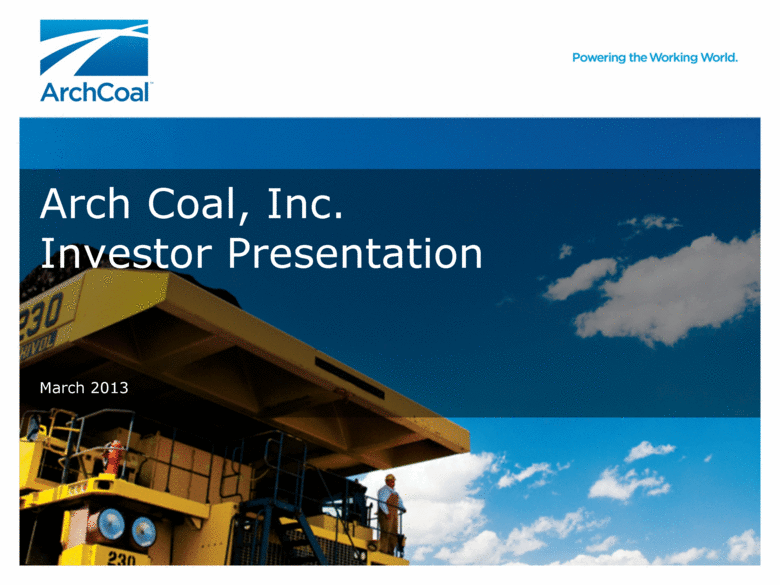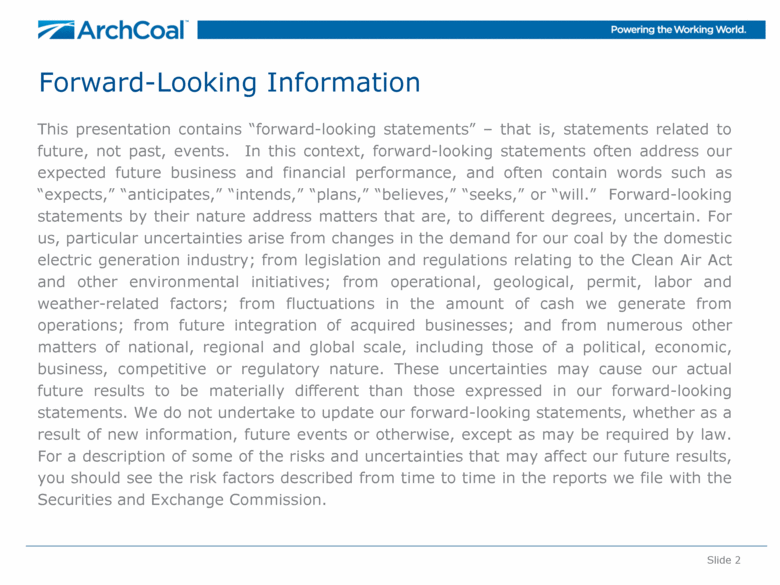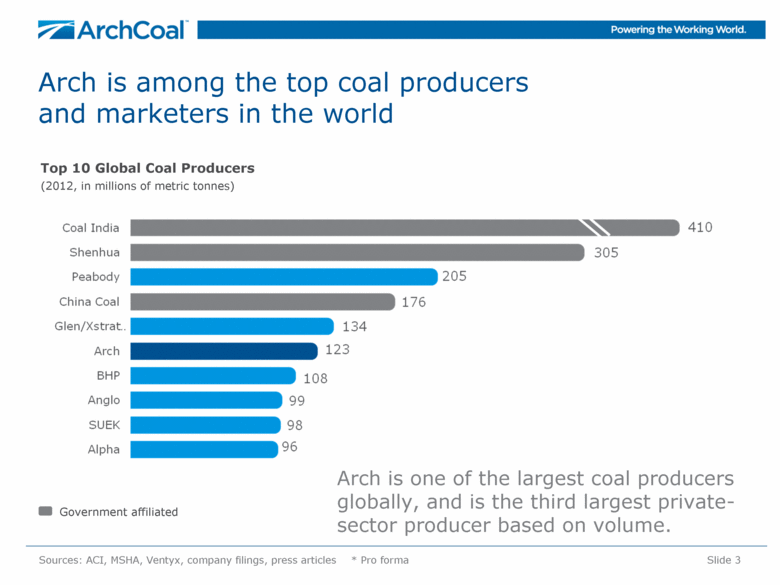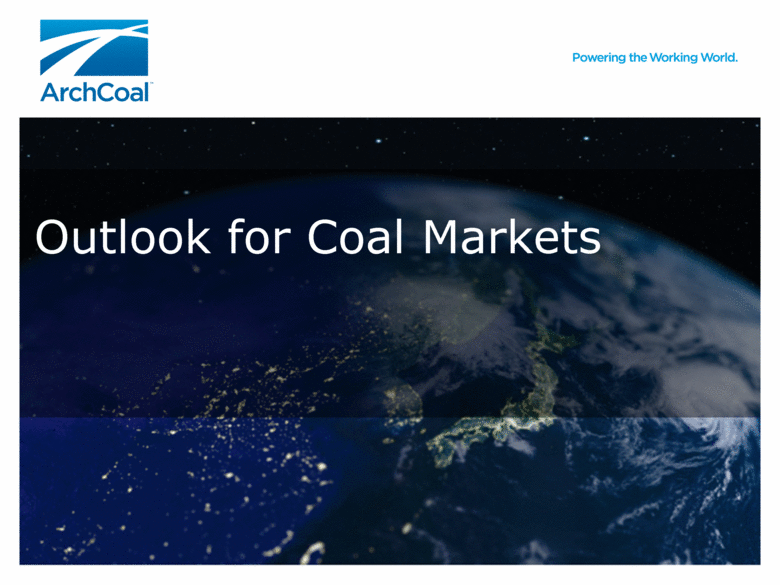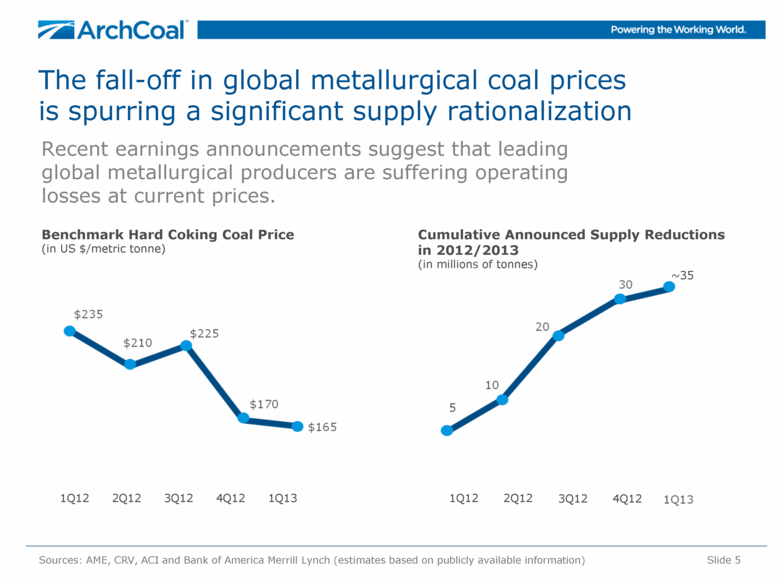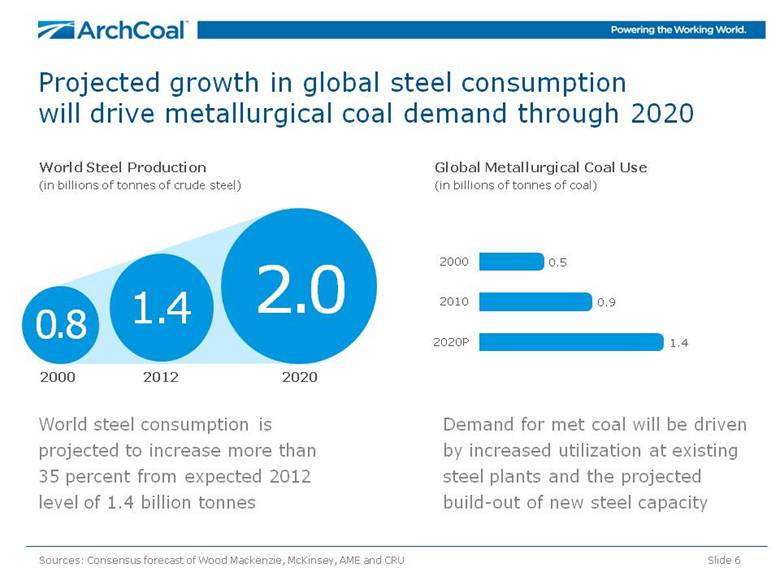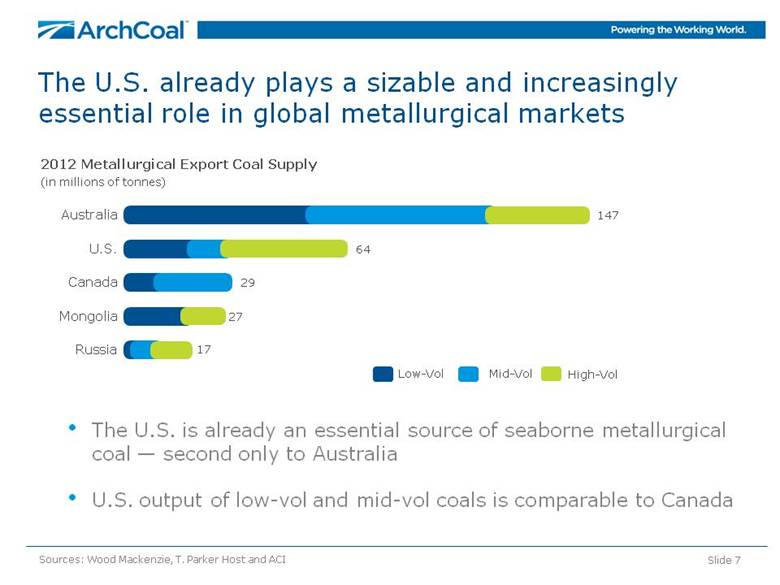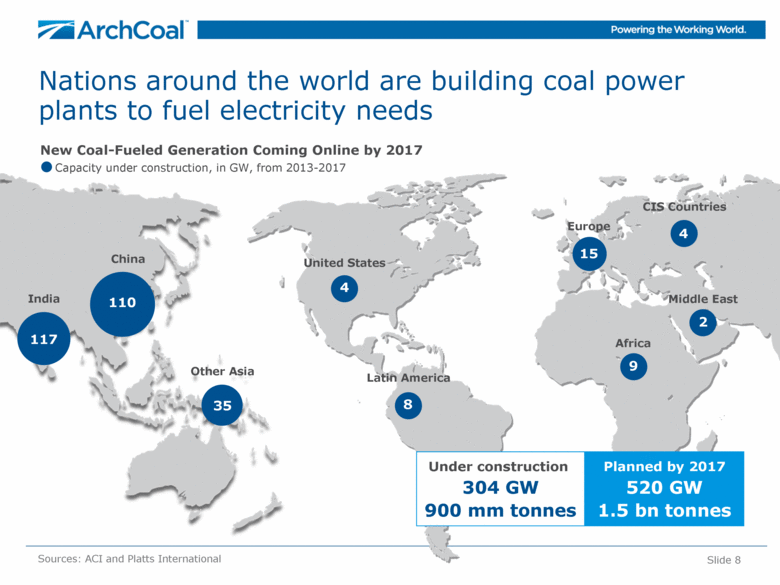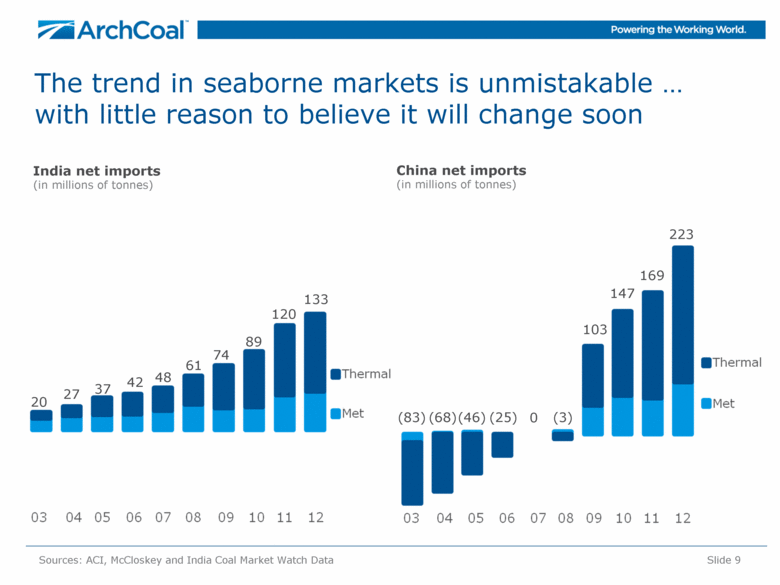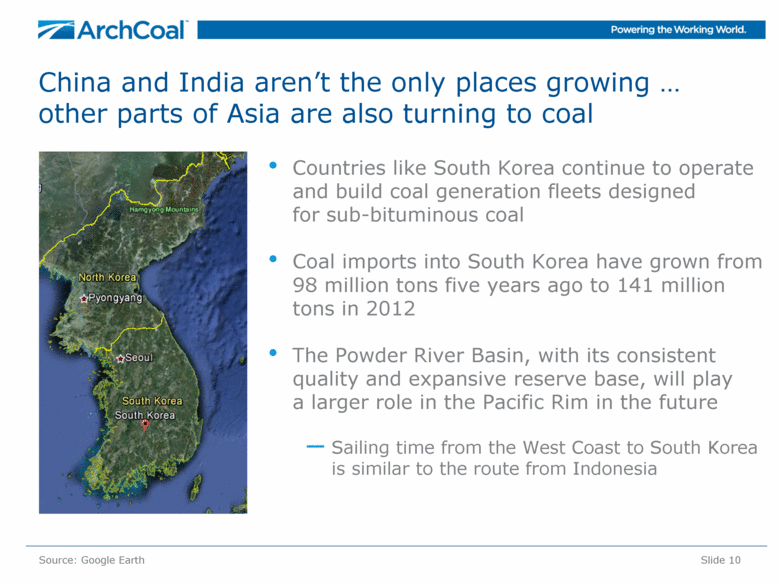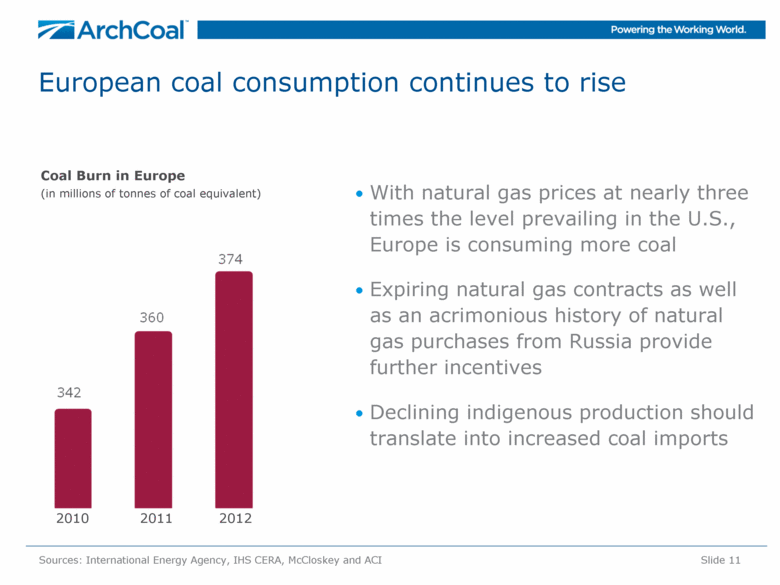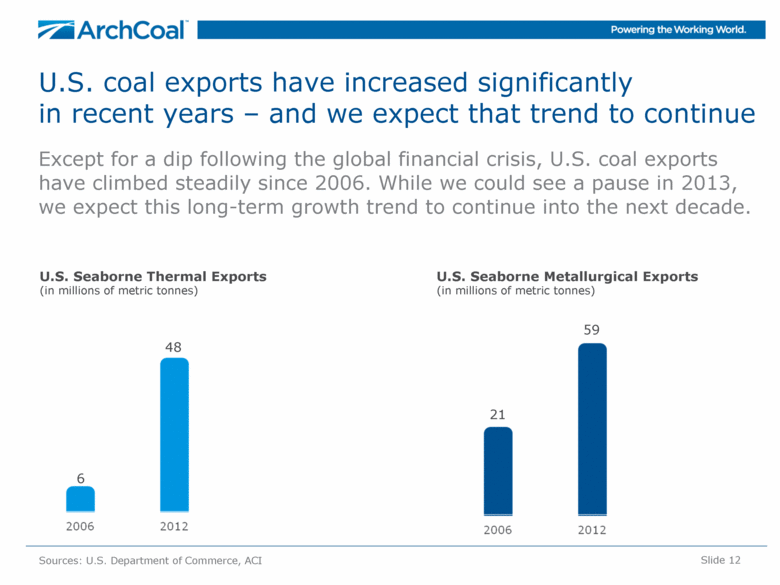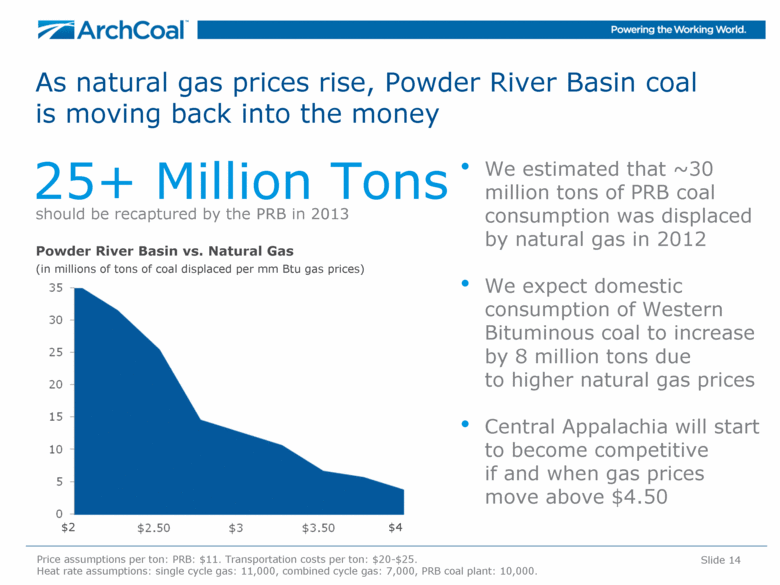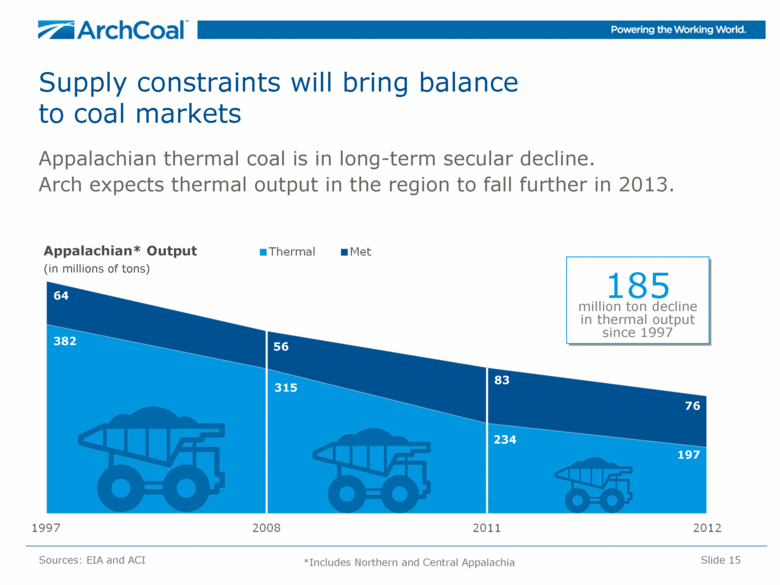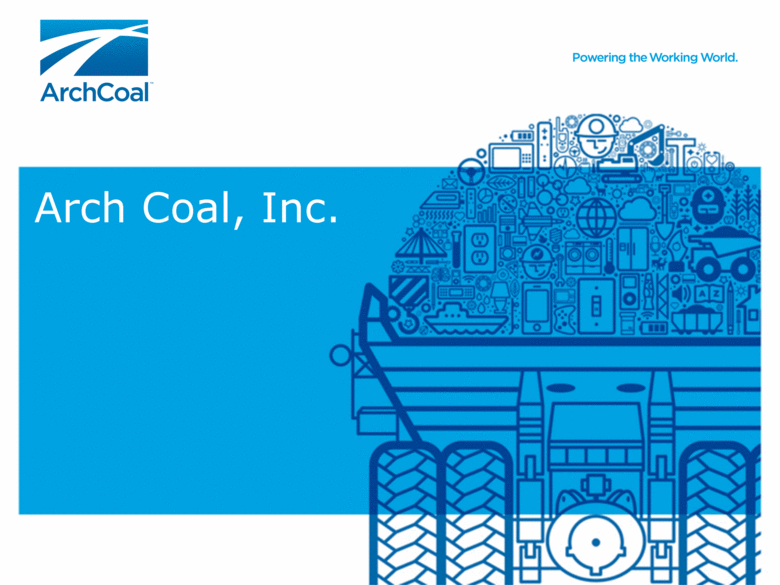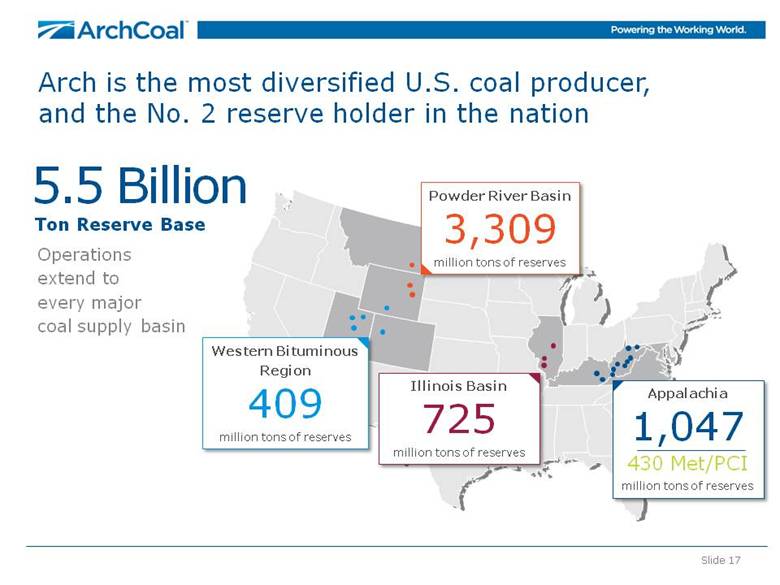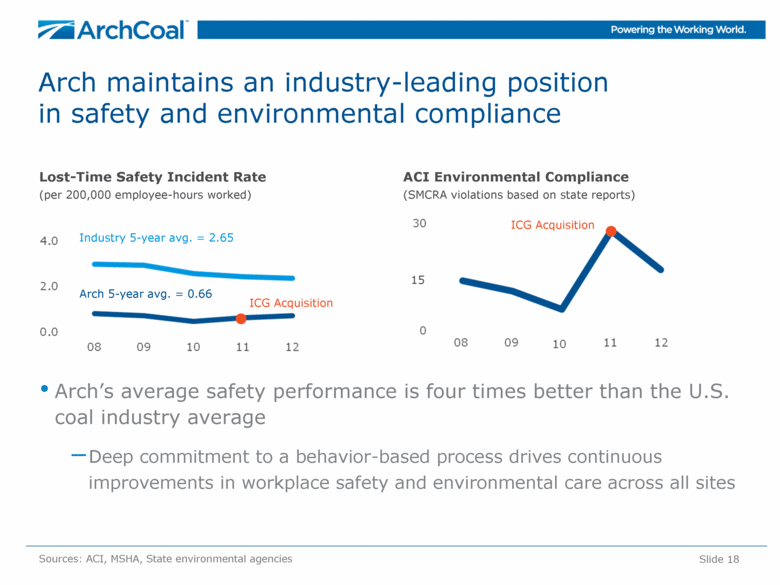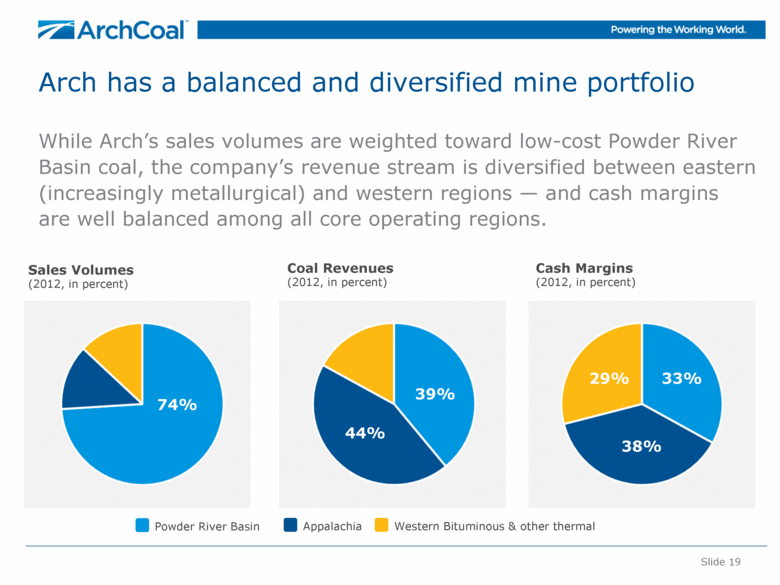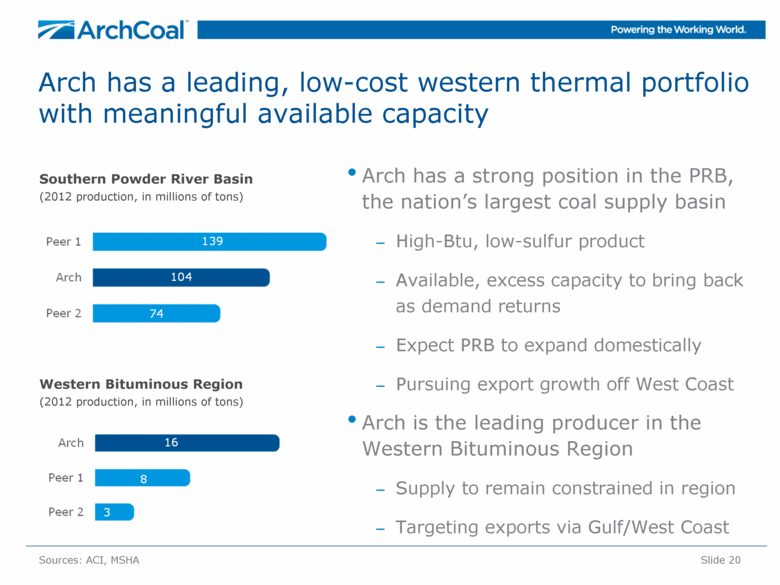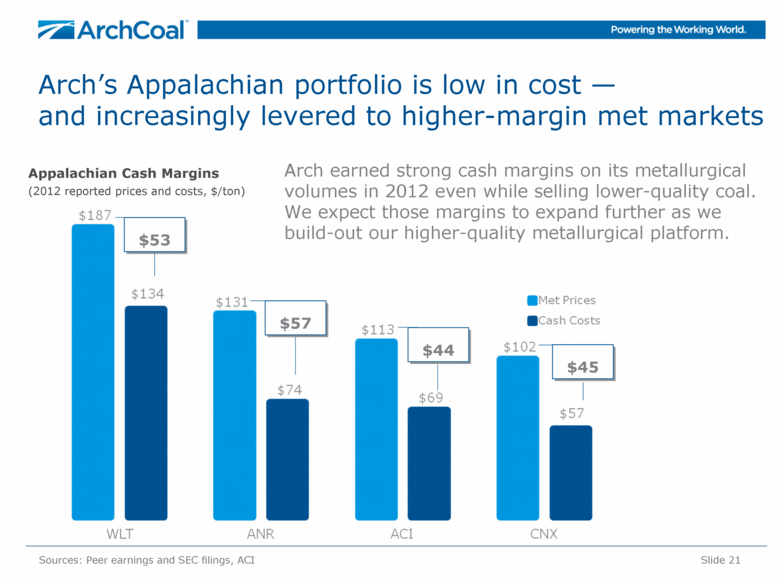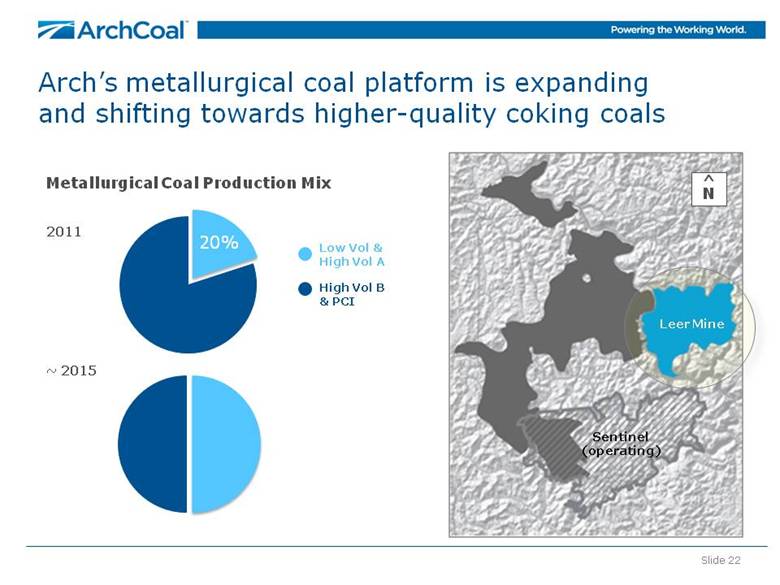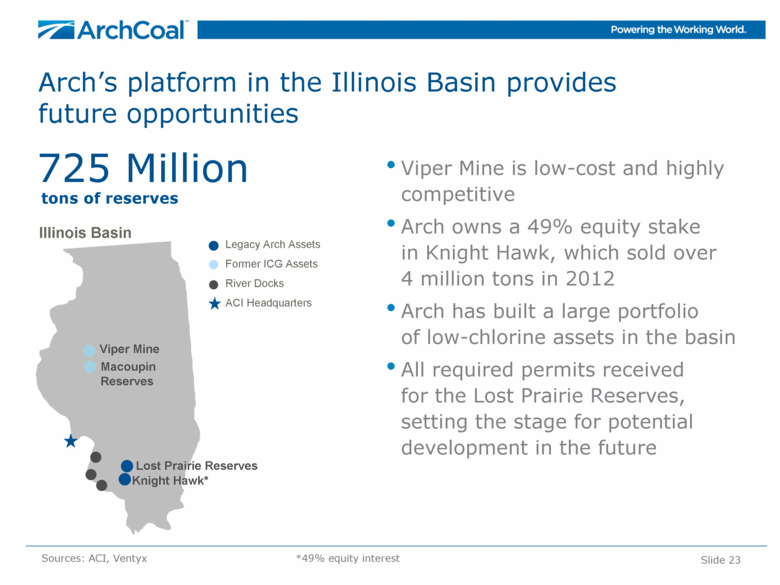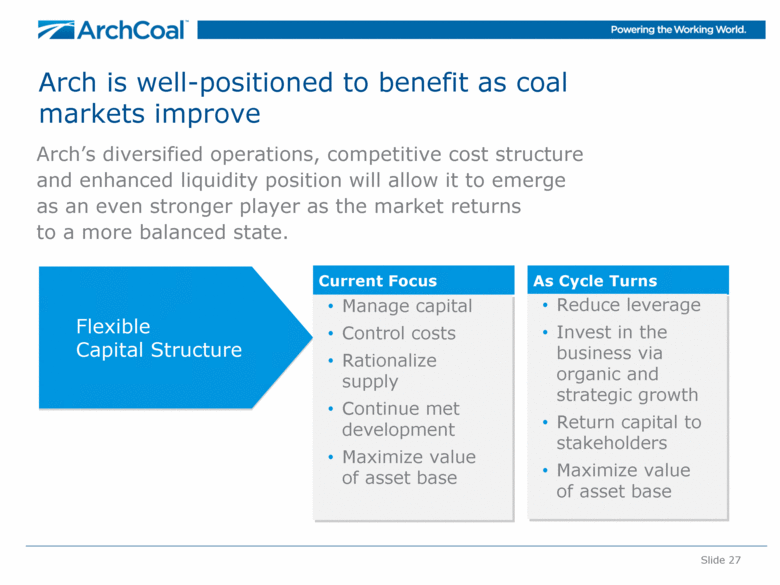Attached files
| file | filename |
|---|---|
| 8-K - 8-K - ARCH RESOURCES, INC. | a13-7797_18k.htm |
Exhibit 99.1
|
|
Arch Coal, Inc. Investor Presentation March 2013 |
|
|
Slide 2 Forward-Looking Information This presentation contains “forward-looking statements” – that is, statements related to future, not past, events. In this context, forward-looking statements often address our expected future business and financial performance, and often contain words such as “expects,” “anticipates,” “intends,” “plans,” “believes,” “seeks,” or “will.” Forward-looking statements by their nature address matters that are, to different degrees, uncertain. For us, particular uncertainties arise from changes in the demand for our coal by the domestic electric generation industry; from legislation and regulations relating to the Clean Air Act and other environmental initiatives; from operational, geological, permit, labor and weather-related factors; from fluctuations in the amount of cash we generate from operations; from future integration of acquired businesses; and from numerous other matters of national, regional and global scale, including those of a political, economic, business, competitive or regulatory nature. These uncertainties may cause our actual future results to be materially different than those expressed in our forward-looking statements. We do not undertake to update our forward-looking statements, whether as a result of new information, future events or otherwise, except as may be required by law. For a description of some of the risks and uncertainties that may affect our future results, you should see the risk factors described from time to time in the reports we file with the Securities and Exchange Commission. |
|
|
Arch is among the top coal producers and marketers in the world Slide 3 Sources: ACI, MSHA, Ventyx, company filings, press articles * Pro forma Top 10 Global Coal Producers (2012, in millions of metric tonnes) Government affiliated Arch is one of the largest coal producers globally, and is the third largest private-sector producer based on volume. Coal India Shenhua Peabody China Coal Glen/Xstrat… Arch BHP Anglo SUEK Alpha 410 305 205 176 134 123 108 99 98 96 |
|
|
|
|
|
Outlook for Coal Markets |
|
|
Slide 5 The fall-off in global metallurgical coal prices is spurring a significant supply rationalization Benchmark Hard Coking Coal Price (in US $/metric tonne) Sources: AME, CRV, ACI and Bank of America Merrill Lynch (estimates based on publicly available information) Cumulative Announced Supply Reductions in 2012/2013 (in millions of tonnes) 1Q12 2Q12 3Q12 4Q12 1Q12 2Q12 3Q12 4Q12 1Q13 ~35 5 Recent earnings announcements suggest that leading global metallurgical producers are suffering operating losses at current prices. |
|
|
Projected growth in global steel consumption will drive metallurgical coal demand through 2020 Slide 6 World steel consumption is projected to increase more than 35 percent from expected 2012 level of 1.4 billion tonnes World Steel Production (in billions of tonnes of crude steel) Sources: Consensus forecast of Wood Mackenzie, McKinsey, AME and CRU Global Metallurgical Coal Use (in billions of tonnes of coal) 2000 2020 2.0 0 .8 Demand for met coal will be driven by increased utilization at existing steel plants and the projected build-out of new steel capacity 1.4 2012 |
|
|
The U.S. already plays a sizable and increasingly essential role in global metallurgical markets Slide 7 Sources: Wood Mackenzie, T. Parker Host and ACI 2012 Metallurgical Export Coal Supply (in millions of tonnes) Low-Vol Mid-Vol High-Vol The U.S. is already an essential source of seaborne metallurgical coal — second only to Australia U.S. output of low-vol and mid-vol coals is comparable to Canada Australia U.S. Canada Mongolia Russia 147 64 29 27 17 |
|
|
Slide 8 Nations around the world are building coal power plants to fuel electricity needs Sources: ACI and Platts International Africa Europe CIS Countries Middle East Other Asia 35 United States 4 Latin America 8 China 110 117 India 9 2 15 4 Under construction 304 GW 900 mm tonnes Planned by 2017 520 GW 1.5 bn tonnes New Coal-Fueled Generation Coming Online by 2017 Capacity under construction, in GW, from 2013-2017 |
|
|
Slide 9 The trend in seaborne markets is unmistakable with little reason to believe it will change soon Sources: ACI, McCloskey and India Coal Market Watch Data China net imports (in millions of tonnes) India net imports (in millions of tonnes) 37 42 48 61 74 89 120 (46) (25) 0 (3) 103 147 169 27 20 (68) (83) 223 133 |
|
|
China and India aren’t the only places growing other parts of Asia are also turning to coal Slide 10 Source: Google Earth Countries like South Korea continue to operate and build coal generation fleets designed for sub-bituminous coal Coal imports into South Korea have grown from 98 million tons five years ago to 141 million tons in 2012 The Powder River Basin, with its consistent quality and expansive reserve base, will play a larger role in the Pacific Rim in the future Sailing time from the West Coast to South Korea is similar to the route from Indonesia |
|
|
European coal consumption continues to rise With natural gas prices at nearly three times the level prevailing in the U.S., Europe is consuming more coal Expiring natural gas contracts as well as an acrimonious history of natural gas purchases from Russia provide further incentives Declining indigenous production should translate into increased coal imports Slide 11 Sources: International Energy Agency, IHS CERA, McCloskey and ACI Coal Burn in Europe (in millions of tonnes of coal equivalent) 2010 2011 2012 |
|
|
Slide 12 Except for a dip following the global financial crisis, U.S. coal exports have climbed steadily since 2006. While we could see a pause in 2013, we expect this long-term growth trend to continue into the next decade. U.S. Seaborne Thermal Exports (in millions of metric tonnes) Sources: U.S. Department of Commerce, ACI U.S. coal exports have increased significantly in recent years – and we expect that trend to continue 6 48 21 59 U.S. Seaborne Metallurgical Exports (in millions of metric tonnes) |
|
|
Slide 13 Arch expects 30% of U.S. coal-fueled units to retire, but the impact on consumption won’t be as great Source: Ventyx, ACI Likely to Continue Likely to Retire Retired Number of units Installed capacity Coal consumption in 2011 |
|
|
As natural gas prices rise, Powder River Basin coal is moving back into the money Slide 14 Powder River Basin vs. Natural Gas (in millions of tons of coal displaced per mm Btu gas prices) 25+ Million Tons should be recaptured by the PRB in 2013 We estimated that ~30 million tons of PRB coal consumption was displaced by natural gas in 2012 We expect domestic consumption of Western Bituminous coal to increase by 8 million tons due to higher natural gas prices Central Appalachia will start to become competitive if and when gas prices move above $4.50 $2 $4 Price assumptions per ton: PRB: $11. Transportation costs per ton: $20-$25. Heat rate assumptions: single cycle gas: 11,000, combined cycle gas: 7,000, PRB coal plant: 10,000. |
|
|
Slide 15 Supply constraints will bring balance to coal markets Appalachian thermal coal is in long-term secular decline. Arch expects thermal output in the region to fall further in 2013. Sources: EIA and ACI 382 64 315 56 234 83 197 76 Appalachian* Output (in millions of tons) 185 million ton decline in thermal output since 1997 *Includes Northern and Central Appalachia |
|
|
Arch Coal, Inc. |
|
|
Arch is the most diversified U.S. coal producer, and the No. 2 reserve holder in the nation Operations extend to every major coal supply basin Slide 17 5.5 Billion Ton Reserve Base Western Bituminous Region 409 million tons of reserves Illinois Basin 725 million tons of reserves Powder River Basin 3,309 million tons of reserves Appalachia 1,047 430 Met/PCI million tons of reserves |
|
|
Arch maintains an industry-leading position in safety and environmental compliance Arch’s average safety performance is four times better than the U.S. coal industry average Deep commitment to a behavior-based process drives continuous improvements in workplace safety and environmental care across all sites Slide 18 Sources: ACI, MSHA, State environmental agencies ACI Environmental Compliance (SMCRA violations based on state reports) Lost-Time Safety Incident Rate (per 200,000 employee-hours worked) Arch 5-year avg. = 0.66 Industry 5-year avg. = 2.65 ICG Acquisition ICG Acquisition 15 |
|
|
Arch has a balanced and diversified mine portfolio While Arch’s sales volumes are weighted toward low-cost Powder River Basin coal, the company’s revenue stream is diversified between eastern (increasingly metallurgical) and western regions — and cash margins are well balanced among all core operating regions. Slide 19 Sales Volumes (2012, in percent) Coal Revenues (2012, in percent) Cash Margins (2012, in percent) Powder River Basin Appalachia Western Bituminous & other thermal 74% 44% 29% 33% 38% 39% |
|
|
Arch has a leading, low-cost western thermal portfolio with meaningful available capacity Arch has a strong position in the PRB, the nation’s largest coal supply basin High-Btu, low-sulfur product Available, excess capacity to bring back as demand returns Expect PRB to expand domestically Pursuing export growth off West Coast Arch is the leading producer in the Western Bituminous Region Supply to remain constrained in region Targeting exports via Gulf/West Coast Slide 20 Sources: ACI, MSHA Western Bituminous Region (2012 production, in millions of tons) Southern Powder River Basin (2012 production, in millions of tons) |
|
|
Sources: Peer earnings and SEC filings, ACI Arch’s Appalachian portfolio is low in cost — and increasingly levered to higher-margin met markets Slide 21 Appalachian Cash Margins (2012 reported prices and costs, $/ton) $53 $57 $44 $45 Arch earned strong cash margins on its metallurgical volumes in 2012 even while selling lower-quality coal. We expect those margins to expand further as we build-out our higher-quality metallurgical platform. |
|
|
Slide 22 Arch’s metallurgical coal platform is expanding and shifting towards higher-quality coking coals Leer Mine Sentinel (operating) ^ N 2011 ~ 2015 High Vol B & PCI Low Vol & High Vol A Metallurgical Coal Production Mix 20% |
|
|
Arch’s platform in the Illinois Basin provides future opportunities Viper Mine is low-cost and highly competitive Arch owns a 49% equity stake in Knight Hawk, which sold over 4 million tons in 2012 Arch has built a large portfolio of low-chlorine assets in the basin All required permits received for the Lost Prairie Reserves, setting the stage for potential development in the future Slide 23 Sources: ACI, Ventyx *49% equity interest Legacy Arch Assets Former ICG Assets River Docks ACI Headquarters Illinois Basin Viper Mine Lost Prairie Reserves Knight Hawk* Macoupin Reserves 725 Million tons of reserves |
|
|
Slide 24 Arch expects to play a larger role in the expanding seaborne coal trade East Coast DTA port in VA Throughput options at other ports Arch’s capacity could approach 10 million tons by 2015 Sources: Wood Mackenzie, ACI 2020 ~2 billion tons 7+ million tons 1 billion tons 2011 ~30 million tons Seaborne coal trade Arch’s export volumes West Coast MBT port in WA Agreement with Ridley in BC, Canada Pursuing additional throughput options at ports along West Coast Gulf Coast River terminals in Illinois Agreement with Kinder Morgan in LA and TX Throughput options at other ports (plus mid-streaming) 13+ million tons 2012 |
|
|
Slide 25 Arch follows a disciplined capital allocation strategy that is scalable based on market conditions Capital Expenditures (in millions) 2013P Spending By Category (based on midpoint of 2013 guidance*) Maintenance *As given on 2/5/13 |
|
|
Total Liquidity (in millions) Arch has fortified its cash position to weather current market downturn Slide 26 *2016 bonds are callable in August 2013 $ 691 $ 1,062 $ 1,113 Short-term debt Existing, unsecured bonds Term loan Available borrowings Cash 2012 Debt Maturity Profile (in millions) Arch’s strategy favors holding cash versus maintaining higher borrowing capacity Relaxed financial maintenance covenants until late 2015 Only a minimum liquidity and senior secured leverage ratio, net of cash, remain in interim No debt maturities until 2016 |
|
|
Arch is well-positioned to benefit as coal markets improve Arch’s diversified operations, competitive cost structure and enhanced liquidity position will allow it to emerge as an even stronger player as the market returns to a more balanced state. Slide 27 Flexible Capital Structure Current Focus Manage capital Control costs Rationalize supply Continue met development Maximize value of asset base As Cycle Turns Reduce leverage Invest in the business via organic and strategic growth Return capital to stakeholders Maximize value of asset base |
|
|
Arch Coal, Inc. Investor Presentation March 2013 |

